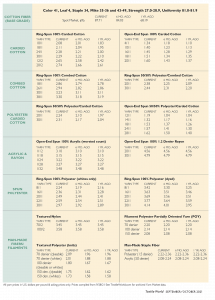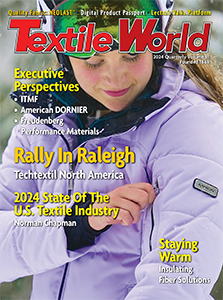 By Jim Phillips, Yarn Market Editor
By Jim Phillips, Yarn Market Editor
The need for source-to-consumer product traceability has been featured multiple times in these pages, dating back more than a decade. Public focus on traceability began as a result of contaminated food. As the frequency and variety of contaminated or faulty products increased over time — ranging from toys laden with lead paint to cell phones that spontaneously burst into flames — consumers began to demand a more rigorous accounting of what their products were made of and from where each component originated. Further, consumers wanted to ensure product claims and labeling were correct. In textile products, for example, class action lawsuits have been filed over the past few years against major retailers for misrepresenting the sheets and bedroom accessories items they were selling. One lawsuit alleged the thread count of sheets was substantially below what was stated on the packaging. Another claimed that sheets sold as 100-percent Egyptian cotton contained only 16 percent of the fiber.
One company, Applied DNA Sciences, has developed a platform — CertainT® — that helps companies assure their customers of the veracity of all product claims. CertainT uses molecular taggant technology to create fully traceable textile supply chains. It was reported earlier this year, for example, that CertainT was the choice for American & Efird when it wanted to introduce a new recycled sewing thread and guarantee its authenticity to customers.
In late September, Applied DNA Sciences reported it received purchase orders from an unnamed textile customer totaling $1.6 million to supply molecular taggant to tag textile fibers.
CertainT’s molecular taggant serves as a unique identifier that can be tested for its presence as the tagged material travels throughout virtually any global supply chain.
Spun Yarn And Global Fibers Market Projected To Grow
The global market for spun yarn, which was estimated at 52 million tons in 2020, is expected to grow to 59.3 million tons by 2026, according to a new report by research firm Global Industry Analysts, Inc. The overall CAGR is projected at 2 percent over the analysis period. CAGR for cotton is projected to be 1.9 percent and reach a total 34.8 million tons. The polyester segment is estimated to have a 2.5 percent CAGR for the period.
The research firm also projects the global market for all textile fibers, estimated at 109.5 million tons in the year 2020, is projected to reach 125.1 million tons by 2026, growing at a CAGR of 2.2 percent over the analysis period. The company also projects the textile fibers market in the United States to be 30.2 million tons for 2021.
New Microfiber Eliminates Recontamination Risk
Skokie,. Ill.-based UMF Corp. has developed a new hospital-grade microfiber that can be converted into a wide range of long-lasting, reusable products, including towels, cubicle curtains, socks, gloves, walk-off mats, reusable N95-rated face masks and color-coded microfiber cleaning products. Manufacturers are using these high-performance Micrillon® microfiber yarns to develop a new standard for materials targeting infection prevention in hospitals, hotels, cruise lines, long term care and many other industries.
“The introduction of Micrillon microfiber puts an end, once and for all, to any question about recontamination related to reusable products,” said UMF Corp. CEO George Clarke. “Some manufacturers and distributors of disposable products — including cubicle curtains, microfiber mops, and wipers — have generated controversy around the risk of reusable products, such as microfiber wipers, recontaminating a patient room, even after being laundered.” This ignores “the fact that after laundering, wipers used in hospitals are immersed in an EPA-registered disinfectant before use — effectively killing bacteria and inactivating viruses.”
Micrillon is a rechargeable polymer additive that can be incorporated into man-made fibers, films, and plastics and then charged with chlorine molecules. The Micrillon chemistry recharges for the life of the product and will not leach into the environment. When microbes come into contact with a Micrillon surface, they are eliminated, and viruses are inactivated.
September/October 2021





